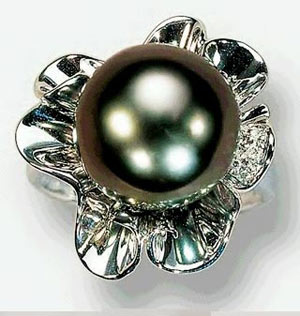Teach you how to identify black pearls
The pearls of the general color do not need to be changed in color. Only the black (dark) pearls are lightly colored because of the low yield. Therefore, the light-colored pearls are colored to make them dark. The current methods of color change include dyeing and radioactive irradiation. Two. 1, dyed pearls Pour the light-colored pearls into a nitric acid solution and ammonia water, then remove them with sunlight or smoke with hydrogen sulfide, which will turn grayish black. 2, irradiation color pearl Light-colored pearls can be blackened by r-irradiation. However, blackened pearls are limited to freshwater pearls containing trace amounts of manganese in fresh water and nacres inside freshwater clam shells. Natural pearls and nacres that are epiphytic in the outer layer of nucleated cultured mother-of-pearl do not change color. That is, radioactively treated black nucleated pearls, the black color comes from the mother-of-pearl, which is black through The colorless nacre on it makes the nucleated cultured pearls appear in the black color of the beads. This black pearl of the permanent irradiation method is also called the Akoya pearl in the international business. The basis for identifying the black pearls with the naked eye is as follows. Point. The color of the cloth dyed black pearl is uniform in color, but in places where there are lesions and cracks, the black color is deep. If you have doubts about the black pearls you hold, you can use a 20% dilute nitric acid solution on cotton to scrub the surface of the dyed black pearls, leaving black marks on the cotton balls. The color of the powder The natural black pearl powder is white in color, while the color of the dyed black pearl powder is black. If you have a small hole in the black pearl, you can use the needle to pick a little powder from the hole to identify it. This is a destructive practice, so be careful when doing it, especially if you can't sculpt it on the black pearl without the hole. Peeking into the kernel, the natural black pearl has a uniform structure and no core. The nucleated cultured black pearls modified with radioactive radiation are in a white pearl layer of 0.5-2 mm thick, and have a black core. From the place where the black pearl has a hole, peep into it with a 10x magnifying glass. But for black pearls that are not drilled, this method does not work. The black pearls that have been color-changed by radiation irradiation, the spectrum of the halo is rich, and accompanied by a strong metallic luster particle size, the pearl of the pearl is born, which is a black pearl that is more black than the palm. The grain size is larger, rarely less than 9mm. Therefore, a round nucleated culture of less than 8mm is black, grayish green or blue-green pearl, which may be a product of radioactive irradiation color change. Another simple method: black natural pearls are very expensive. When buying, be sure to pay attention to the difference between them and dyed pearls. Under certain conditions, be sure to put the pearls under the fluorescent light and see that there is no red fluorescence. Red fluorescent, it is a natural pearl, otherwise it is a color-changing pearl. If there is no fluorescent lamp, you can use a cotton ball to rub a 20% dilute nitric acid solution gently in the inconspicuous part of the pearl, if the pearl is dyed, on the cotton Will leave black marks, generally do not buy at random if you are not sure.
Double face wool fabrics is fabric where either side can be used, these fabrics only have one layer of fabric and cannot be separated.
These fabrics can easily be used for reversible garments including dresses or skirts.
Double-Faced Wool Fabric offers our customers so many design options and possibilities because it has two sides of fabric to process .
Double Face Wool Fabric,Double-Faced Wool Fabric,Wool Fabric,Wool Fabric 100% SHANDONG XINGTENG INTERNATIONAL TRADE CO., LTD. , https://www.woolfabric.be